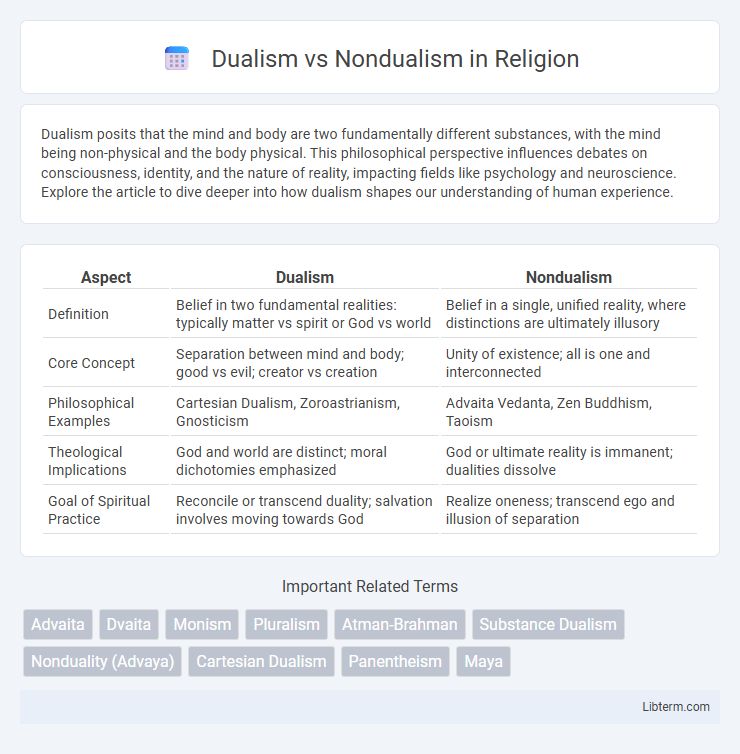Dualism posits that the mind and body are two fundamentally different substances, with the mind being non-physical and the body physical. This philosophical perspective influences debates on consciousness, identity, and the nature of reality, impacting fields like psychology and neuroscience. Explore the article to dive deeper into how dualism shapes our understanding of human experience.
Table of Comparison
| Aspect | Dualism | Nondualism |
|---|---|---|
| Definition | Belief in two fundamental realities: typically matter vs spirit or God vs world | Belief in a single, unified reality, where distinctions are ultimately illusory |
| Core Concept | Separation between mind and body; good vs evil; creator vs creation | Unity of existence; all is one and interconnected |
| Philosophical Examples | Cartesian Dualism, Zoroastrianism, Gnosticism | Advaita Vedanta, Zen Buddhism, Taoism |
| Theological Implications | God and world are distinct; moral dichotomies emphasized | God or ultimate reality is immanent; dualities dissolve |
| Goal of Spiritual Practice | Reconcile or transcend duality; salvation involves moving towards God | Realize oneness; transcend ego and illusion of separation |
Introduction to Dualism and Nondualism
Dualism posits the existence of two fundamental and distinct realities, typically mind and matter, emphasizing their separate and independent natures. Nondualism challenges this separation by asserting a unified, singular reality where distinctions between mind and matter dissolve. These contrasting philosophies form the basis of many metaphysical, spiritual, and cognitive discussions, influencing perspectives on consciousness, existence, and the nature of self.
Historical Origins of Dualist and Nondualist Thought
Dualism traces its philosophical roots to ancient Greek thinkers like Plato and Rene Descartes, emphasizing the distinction between mind and body as separate substances. Nondualism originates primarily from Eastern traditions such as Advaita Vedanta in Hinduism and Mahayana Buddhism, advocating the fundamental oneness of all existence beyond apparent distinctions. These contrasting views have shaped centuries of metaphysical discourse, influencing diverse spiritual and philosophical systems worldwide.
Core Principles of Dualism
Dualism posits the existence of two fundamentally distinct substances or realities, often characterized as mind and body, or spirit and matter, which interact but remain separate. Its core principle emphasizes the separation between consciousness and the physical world, asserting that mental phenomena cannot be fully reduced to physical processes. This viewpoint underlines the dualistic nature of existence, contrasting with monistic or nondual philosophies that perceive reality as a unified whole.
Fundamental Tenets of Nondualism
Nondualism asserts that reality is an indivisible whole, emphasizing the unity of the self and the universe beyond apparent dualities such as mind and body or subject and object. Its fundamental tenets include the recognition of an underlying singular consciousness or essence, often identified as Brahman or Atman in Advaita Vedanta, which transcends individual ego and mental distinctions. This philosophy promotes experiential realization through meditation and self-inquiry, revealing that separateness is an illusion and true knowledge arises from the direct apprehension of oneness.
Dualism in Western Philosophy and Religion
Dualism in Western philosophy and religion primarily posits the existence of two fundamental and distinct realities, often characterized as mind and body or spirit and matter, shaping doctrines in Christianity and Cartesian philosophy. Rene Descartes famously articulated substance dualism, asserting that mind and body are separate substances that interact but possess different essential natures--res cogitans (thinking substance) and res extensa (extended substance). This dualistic framework profoundly influences Western religious thought by emphasizing the soul's immortality and its distinction from the physical body, reinforcing themes of divine transcendence and moral duality.
Nondualism in Eastern Philosophical Traditions
Nondualism in Eastern philosophical traditions, particularly Advaita Vedanta and Zen Buddhism, emphasizes the fundamental oneness of reality, rejecting the dualistic separation between self and other, subject and object. This perspective asserts that the apparent multiplicity and distinctions are illusions (maya) arising from ignorance (avidya), and true knowledge (jnana) reveals the indivisible nature of consciousness (Brahman or Sunyata). Meditation practices and self-inquiry techniques aim to transcend dualistic perceptions, leading practitioners to experience direct realization of non-separation and ultimate unity.
Comparative Analysis: Key Differences and Similarities
Dualism posits the existence of two fundamentally distinct realities, typically mind and matter, while Nondualism asserts an underlying unified reality transcending this dichotomy. Key differences include Dualism's emphasis on separation and interaction between entities, contrasted with Nondualism's focus on inherent oneness and interconnectedness. Both philosophies explore consciousness and reality's nature, aiming to explain human experience but diverge significantly in their metaphysical frameworks.
Dualism and Nondualism in Modern Spirituality
Dualism in modern spirituality emphasizes the distinction between the self and the universe, often framing existence as a separation between mind and matter or spirit and body. Nondualism challenges this separation, advocating for an experience of oneness where the individual self and the cosmos are interconnected and inseparable. Contemporary spiritual practices incorporate nondual insights to foster unity consciousness, while dualistic perspectives remain prevalent in traditions that highlight personal identity and distinct spiritual goals.
Psychological and Practical Implications of Each View
Dualism, which posits a separation between mind and body, often fosters a psychological framework emphasizing individual identity and personal responsibility, potentially leading to increased self-awareness but also internal conflict. Nondualism challenges this separation by promoting the idea of interconnectedness and unity, encouraging psychological flexibility and reducing the ego-driven stress that arises from perceived dualities. Practically, dualism supports structured therapeutic approaches targeting mind-body distinctions, while nondualism inspires mindfulness practices that cultivate holistic well-being and resilience.
Contemporary Debates and Future Perspectives
Contemporary debates on dualism versus nondualism explore the metaphysical implications of consciousness and reality, with dualism emphasizing the separation of mind and matter while nondualism advocates for an integrated, indivisible existence. Advances in neuroscience and quantum physics challenge traditional dualistic views, suggesting a more interconnected understanding of the mind-body relationship. Future perspectives emphasize interdisciplinary research combining philosophy, cognitive science, and spirituality to develop coherent models that bridge subjective experience and objective reality.
Dualism Infographic

 libterm.com
libterm.com